Silica gel packets are essential for drying herbs, as they absorb moisture and keep your herbs fresh. They contain tiny beads that attract water from the air, preventing mold and spoilage while maintaining flavor and aroma. Just place silica gel in an airtight container with your herbs, ensuring they're well-covered. Not only do these packets extend shelf life, but they're also reusable—simply regenerate them by heating. Always choose food-grade silica gel for safety. If you're curious about the best practices for using these packets or alternatives for drying herbs, you'll find plenty of helpful tips ahead.
What Is Silica Gel?
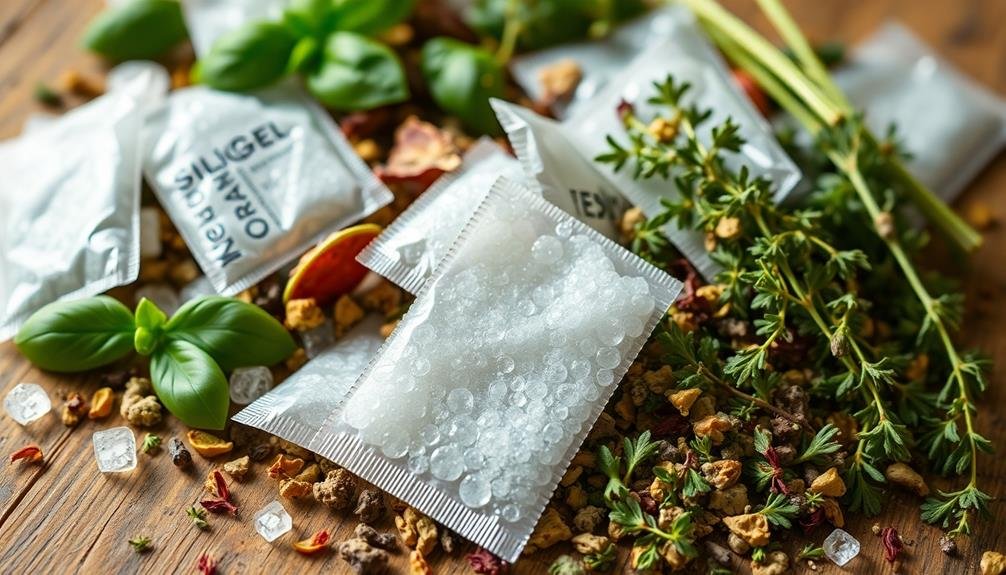
What exactly is silica gel? It's a granular, porous form of silicon dioxide, a compound found in sand and quartz. You've probably seen it in little packets labeled "Do Not Eat" that come with various products like shoes or electronics. Silica gel is designed to absorb moisture, making it incredibly useful in preventing mold, mildew, and spoilage.
You might be surprised to learn that silica gel isn't actually a gel. Instead, it's a solid that comes in tiny beads or granules. Its structure allows it to hold water vapor efficiently, which is why it's commonly used in packaging. When you open a packet, you're getting a powerful desiccant that works to keep items dry.
In your quest for drying herbs, silica gel packets can be a game changer. They help maintain the flavor and aroma of your herbs by absorbing excess moisture, ensuring they don't lose quality over time.
You'll appreciate how easy it's to incorporate silica gel into your herb storage routine. With its versatility and effectiveness, silica gel is an essential tool for anyone serious about preserving their herbs.
How Silica Gel Works
To understand how silica gel works, you need to look at its moisture absorption process.
When you place silica gel packets with your herbs, they attract and hold onto the moisture in the air, keeping your herbs dry.
Plus, you can regenerate and reuse these packets, making them a practical choice for long-term herb storage.
Moisture Absorption Process
Many people mightn't realize how effective silica gel is at absorbing moisture. When you place silica gel packets near your herbs, they actively draw in excess humidity from the surrounding air.
This process occurs because silica gel is composed of tiny, porous beads made from silicon dioxide. These beads have a high surface area, allowing them to trap water molecules efficiently.
As the moisture-laden air interacts with the silica gel, the water molecules stick to the surface of the beads, effectively lowering the humidity in the environment. This reduces the chances of mold and spoilage, keeping your herbs fresh and flavorful for longer.
You might notice that the silica gel changes color when it's saturated, signaling that it's time to replace or recharge the packets.
Using silica gel is a simple, effective way to maintain ideal drying conditions for your herbs. Just remember, the more silica gel you use, the more moisture it can absorb.
Regeneration and Reuse
Silica gel packets can be easily regenerated and reused, making them a sustainable choice for drying herbs. When you notice the packets have absorbed moisture and changed color, it's time to regenerate them. This process involves removing the moisture trapped in the silica gel, allowing it to function effectively once again.
To regenerate your silica gel packets, simply preheat your oven to about 200°F (93°C). Spread the packets out on a baking sheet, ensuring they don't overlap. Place the sheet in the oven for about two hours. Keep an eye on them to prevent overheating or burning.
Once they're done, let them cool before using them again.
You might also consider using a microwave for faster regeneration. Place the packets in a microwave-safe container, adding a cup of water to prevent overheating. Heat them in short intervals, checking every 30 seconds until they're dry.
Benefits of Silica Gel Packets
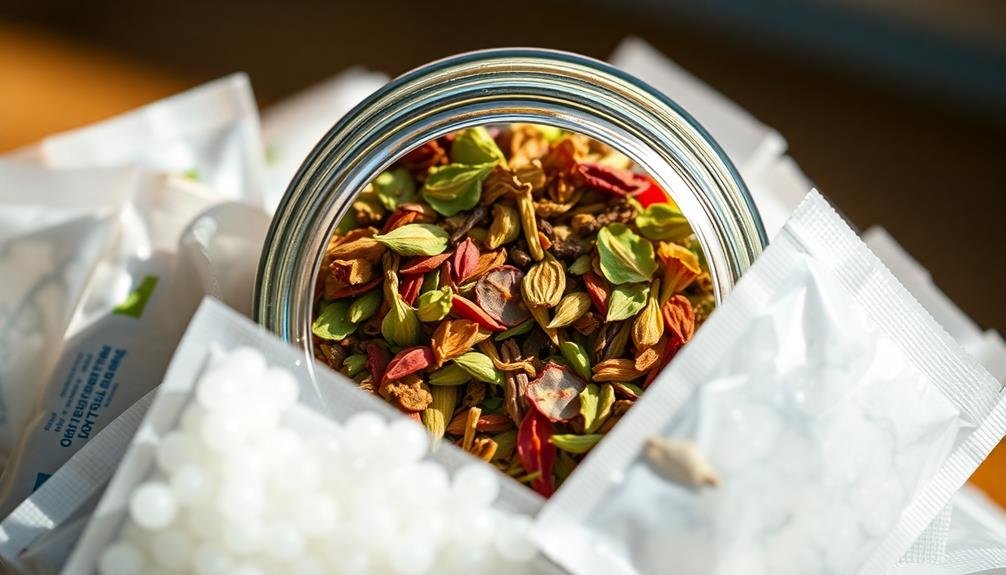
Using silica gel packets offers impressive moisture absorption efficiency, ensuring your herbs stay dry and vibrant.
Not only do they help preserve the flavor of your herbs, but they also extend their shelf life considerably.
Moisture Absorption Efficiency
When it comes to drying herbs, silica gel packets offer an impressive moisture absorption efficiency that can greatly enhance your results. These small packets contain silica crystals that absorb moisture effectively, ensuring your herbs dry thoroughly without the risk of mold or spoilage.
You'll find that using silica gel is a straightforward solution to maintaining the quality of your herbs. Unlike air drying, which can be inconsistent and time-consuming, silica gel works quickly and efficiently. You can simply place your herbs in a container with the packets, and they'll draw moisture away from the plant material, allowing for faster drying times.
This method also minimizes the exposure to air, which can degrade your herbs during the drying process. Additionally, silica gel packets are reusable. After they've absorbed moisture, you can regenerate them by drying them out in an oven, making them a cost-effective choice.
You'll appreciate how easy it's to keep your herbs dry and safe from humidity, ensuring they're ready for use in your favorite recipes or for storage. Overall, silica gel packets provide an effective way to manage moisture levels in your herb drying efforts.
Preservation of Flavor
Maintaining the flavor of your herbs is just as important as ensuring they're dried properly. When you use silica gel packets, you're not just controlling moisture; you're also preserving the essential oils that give your herbs their unique taste.
These packets effectively absorb excess moisture, which helps prevent the growth of mold and bacteria that can ruin flavor. By keeping your herbs dry, silica gel packets allow the natural aromas and flavors to remain intact.
You'll notice a significant difference in the taste of your dishes when you use herbs that were stored properly compared to those that weren't. Silica gel packets help retain that vibrant flavor, ensuring your culinary creations shine.
Additionally, silica gel packets are easy to use and can be placed directly in your herb storage containers. This means you won't have to worry about complicated techniques or special storage methods.
Just pop a few packets in, and let them do the work for you. With silica gel packets, you'll enjoy fresher-tasting herbs that enhance your meals and elevate your cooking experience.
Embrace this simple yet effective method to keep your herbs flavorful and aromatic.
Extended Shelf Life
For anyone looking to extend the shelf life of their dried herbs, silica gel packets serve as an invaluable ally. These tiny powerhouses absorb moisture, which is essential since excess humidity can lead to mold growth and spoilage. By placing silica gel packets in your herb storage containers, you're creating an environment that keeps your herbs fresh and potent for longer.
You might be surprised at how effective these packets can be. Silica gel can help prevent clumping and maintain the texture of your herbs, ensuring they remain easy to use.
Plus, when herbs retain their original moisture content, their flavor and aroma stay intact, enhancing your culinary creations.
Using silica gel packets also means you won't have to worry as much about frequent replacements. With proper care, your herbs can last well beyond their typical shelf life, saving you money and reducing waste.
Just remember to check the packets periodically and recharge or replace them as needed. By taking this simple step, you're not just preserving herbs; you're investing in the quality and longevity of your cooking ingredients.
Enjoy the benefits of extended shelf life with the help of silica gel packets!
Choosing the Right Silica Gel
Choosing the right silica gel can greatly impact the effectiveness of your herb drying process. When selecting silica gel packets, consider the type and size that'll best suit your needs. Opt for food-grade silica gel, as it's safe for use with edible herbs. This guarantees that no harmful chemicals will leach into your herbs during the drying process.
Next, think about the size of the silica gel packets. Smaller packets might work well for drying a few herbs at a time, while larger packets are better for bulk drying. If you're working with delicate herbs, choose packets that offer a gentler drying process to avoid damaging them.
You should also check the color indicator of the silica gel. Some packets change color when they're saturated, making it easier for you to know when to replace or recharge them.
Finally, keep an eye on the moisture capacity. Higher capacity packets will absorb more moisture, which can be advantageous for maintaining the quality of your dried herbs.
Using Silica Gel for Drying
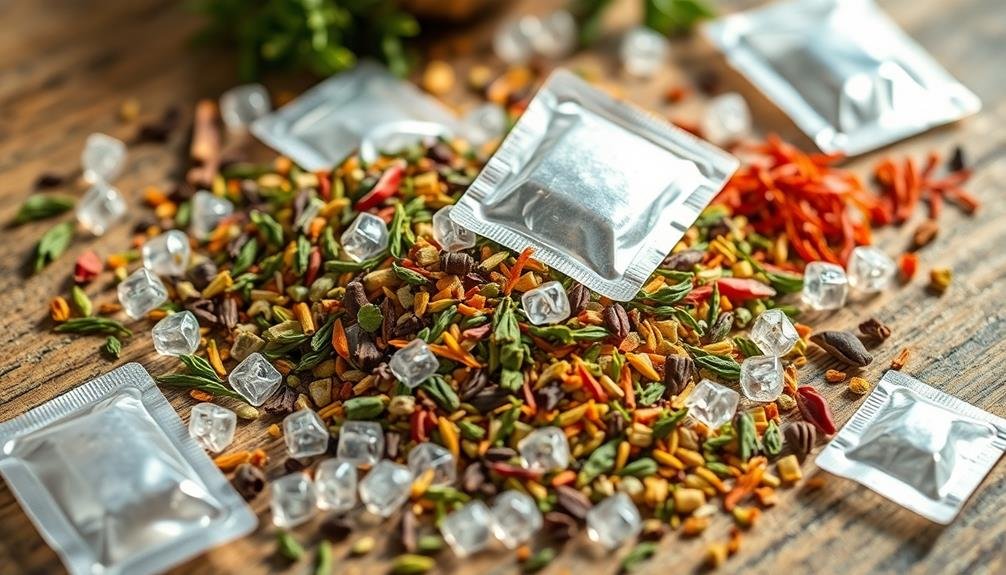
Once you've selected the right silica gel, it's time to put it to use in drying your herbs effectively. Start by gathering your fresh herbs, ensuring they're free of moisture and dirt. You want them in their prime, so harvest just before they reach full bloom for the best flavor.
Next, choose a suitable container—preferably a shallow, airtight one. Spread a layer of silica gel at the bottom, about half an inch thick. Lay your herbs flat on this layer, making sure they don't overlap. This allows the silica gel to draw moisture from all sides.
Once your herbs are arranged, gently cover them with more silica gel, ensuring they're completely enveloped. Seal the container tightly and store it in a cool, dry place.
Check the herbs after a couple of days; they should feel dry and crumbly. If they still seem moist, leave them for another day or two. Once dried, carefully remove the herbs from the silica gel and store them in an airtight container.
This method preserves their aroma and potency, making your dried herbs last longer.
Best Practices for Herb Drying
Effective herb drying hinges on understanding key practices that enhance flavor and shelf life. To get the best results, start by selecting fresh, healthy herbs. Wash them gently, and remove any damaged leaves. Next, use the right drying method for the type of herb you're working with. Air drying works well for sturdy herbs like rosemary, while delicate herbs like basil benefit from quicker methods, like using silica gel packets.
Here's a quick reference table for your drying methods:
| Method | Best For |
|---|---|
| Air Drying | Sturdy herbs (e.g., thyme) |
| Silica Gel | Delicate herbs (e.g., basil) |
| Oven Drying | Quick drying (set to low) |
| Dehydrator | Consistent results |
Keep your drying area cool, dark, and well-ventilated to prevent mold and preserve color. Check your herbs regularly, and when they're fully dried, store them in airtight containers. Remember, the quicker and more efficient your drying process, the better your herbs will taste once they're ready to use!
Storing Dried Herbs Effectively

Once you've dried your herbs, storing them properly is essential to maintain their flavor and potency.
You'll want to choose the right containers, manage humidity levels, and follow some long-term storage tips to keep them fresh.
Let's explore how to do this effectively.
Optimal Container Choices
Choosing the right container is essential for preserving the freshness and potency of dried herbs. You'll want to select materials that protect your herbs from light, air, and moisture.
Glass jars are an excellent choice; they're airtight and won't leach chemicals into your herbs. Opt for dark-colored glass if possible, as it blocks out harmful UV rays that can degrade the quality of your herbs over time.
Plastic containers can work, but be cautious. Verify they're food-grade and BPA-free. If you use plastic, look for containers with tight-fitting lids to minimize exposure to air. Avoid using clear plastic, as it allows light to penetrate.
Metal tins can also be effective, provided they're lined to prevent rust and corrosion. Just make sure they're airtight to keep moisture and air at bay.
Remember to label your containers with the herb's name and the date you dried them, so you can keep track of freshness.
Ultimately, the goal is to create an environment where your dried herbs can thrive. With the right container, you'll guarantee that your herbs maintain their flavor and potency for as long as possible.
Proper Humidity Control
Humidity control is essential for maintaining the quality of dried herbs. Excess moisture can lead to mold growth, spoilage, and a loss of flavor and potency. To keep your herbs fresh, you'll want to guarantee they're stored in an environment with low humidity.
Using silica gel packets is a practical way to achieve this. These packets absorb excess moisture and help maintain an ideal humidity level within your storage containers. When you place them alongside your dried herbs, they work to prevent moisture buildup. However, it's important to monitor the packets and replace them as needed, especially if you notice them becoming saturated.
Additionally, keep your herbs in a cool, dark place. Light and heat can further degrade the quality of your herbs, so choose your storage spot wisely.
You might also consider using airtight containers to minimize air exposure, which can introduce moisture.
Long-Term Storage Tips
To guarantee your dried herbs remain flavorful and potent over time, it's crucial to follow effective long-term storage practices. Here are some tips to help you store your herbs properly:
- Choose Airtight Containers: Use glass jars, vacuum-sealed bags, or other airtight containers to prevent moisture and air from degrading your herbs.
- Store in a Cool, Dark Place: Keep your containers in a cool, dark location, ideally a pantry or cupboard, to protect them from light and heat, which can cause flavor loss.
- Label and Date: Make sure to label each container with the herb's name and the date of storage. This helps you keep track of freshness and guarantees you use older herbs first.
- Avoid Frequent Opening: Limit how often you open your containers. Each time you do, moisture and air can seep in, affecting the quality of your herbs.
Safety Considerations With Silica Gel
While silica gel packets are popular for drying herbs, it's important to understand their safety considerations. First off, you should know that most silica gel packets are labeled "Do Not Eat." This warning exists because silica gel is a desiccant, not food, and ingesting it can cause choking or gastrointestinal issues.
Keep these packets away from children and pets to avoid any accidents.
When using silica gel for drying herbs, verify the packets are food-grade if you plan to store herbs for culinary use. Regular silica gel may have chemical treatments that aren't safe for food contact. Always check for safety certifications on the packaging.
Additionally, avoid exposing silica gel packets to moisture once they've absorbed it. If they become saturated, they can lose effectiveness and may even develop mold if left in a damp environment.
Alternatives to Silica Gel
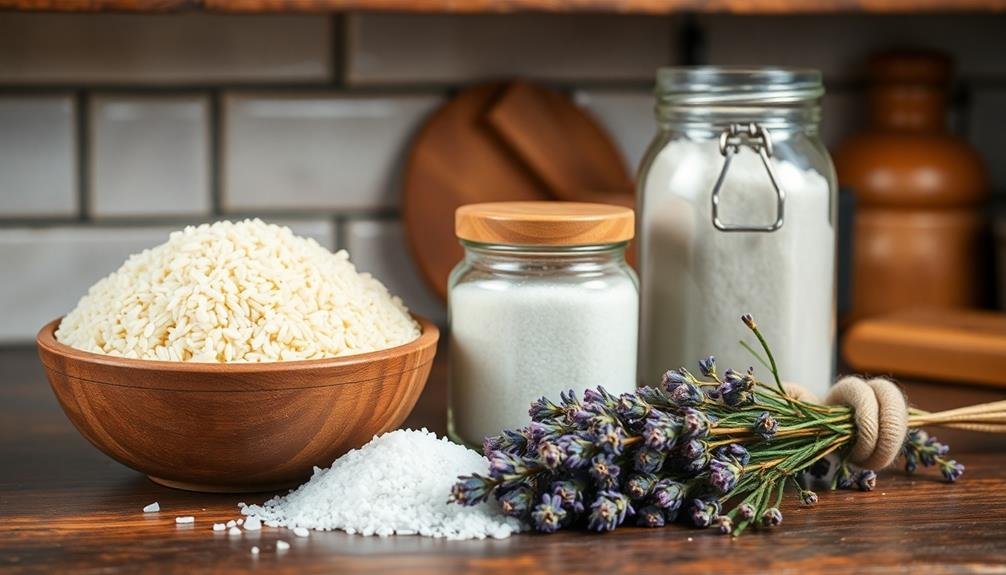
If you're looking for alternatives to silica gel for drying herbs, there are several effective options. You can achieve excellent results with natural materials that are often more accessible and safer to use.
- Rice: Plain, uncooked rice can absorb moisture effectively. Place your herbs in a container filled with rice, ensuring they're fully submerged for ideal drying.
- Salt: Like rice, salt is a natural desiccant. Use kosher or sea salt to layer your herbs in a container, which will draw out moisture and preserve flavor.
- Oven Drying: If you're in a hurry, use your oven. Set it to the lowest temperature (around 150°F or 65°C) and spread herbs on a baking sheet. Keep the door slightly ajar to allow moisture to escape.
- Air Drying: For a no-cost option, simply tie your herbs in small bundles and hang them upside down in a cool, dark, and well-ventilated area. This method takes longer but maintains the herb's essential oils.
These alternatives can be just as effective as silica gel, providing you with dried herbs ready for use in your culinary creations.
Incorporating Dried Herbs in Tea
Incorporating dried herbs in your tea can elevate your brewing experience and add unique flavors. Whether you're a seasoned tea drinker or a curious novice, using dried herbs allows you to customize your drink to suit your taste. You can experiment with various combinations, discovering what works best for you.
To get started, choose your favorite dried herbs. Options like chamomile, peppermint, or hibiscus can create delightful blends. Just remember to weigh the strength of the herbs; some, like rosemary or sage, can be quite potent. A little goes a long way!
When you're ready to brew, add about one teaspoon of dried herbs per cup of water. Bring the water to a boil, then let it cool slightly before pouring it over the herbs. Steep for 5 to 10 minutes, depending on how strong you like your tea. You can adjust the steeping time to achieve your desired flavor.
Once your tea is ready, strain out the herbs and enjoy! You'll find that each sip reveals the complexity and depth of flavor that dried herbs can provide, making your tea-drinking experience all the more enjoyable.
DIY Herbal Tea Blend Ideas
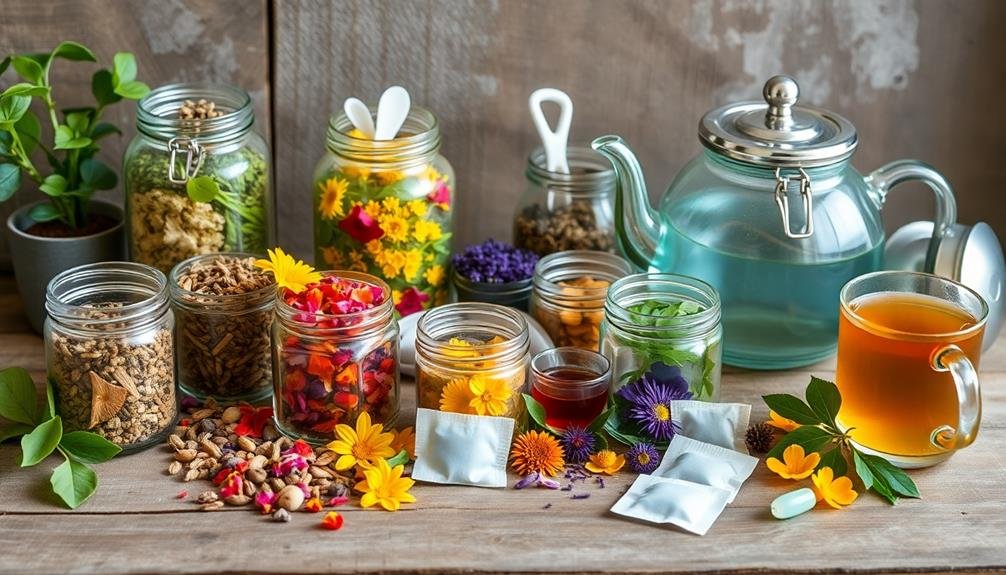
Creating your own herbal tea blends offers a delightful sense of creativity and personalization. You can experiment with flavors, aromas, and health benefits to craft the perfect cup.
Here are some DIY herbal tea blend ideas to inspire your brewing adventure:
- Calming Chamomile: Mix chamomile flowers with dried lavender and lemon balm. This soothing blend is perfect for winding down after a long day.
- Invigorating Mint: Combine peppermint leaves with green tea and a hint of ginger. This invigorating blend not only wakes you up but also aids digestion.
- Citrus Spice: Blend dried hibiscus petals with orange peel and a sprinkle of cinnamon. It's a zesty, tart infusion that can be enjoyed hot or iced.
- Detox Delight: Mix dandelion root, nettle leaves, and a touch of fennel. This purifying blend supports your body's natural detoxification processes.
Feel free to adjust the ratios to match your taste preferences.
With each blend, you'll find a unique flavor profile that not only satisfies your palate but also enhances your well-being. Enjoy the process!
Frequently Asked Questions
Can I Reuse Silica Gel Packets After Drying Herbs?
Yes, you can reuse silica gel packets after drying herbs. Just make sure to reactivate them by baking at a low temperature to remove moisture. They'll be ready for your next drying project!
How Long Do Silica Gel Packets Last?
Silica gel packets can last quite a while if stored properly. They typically remain effective for several months, but you should check their moisture indicator regularly to ascertain they're still doing their job effectively.
Are Silica Gel Packets Toxic to Pets?
Silica gel packets aren't toxic to pets, but they can pose a choking hazard. Always keep them out of reach to avoid any potential issues, and watch your pets closely if they show interest.
Where Can I Buy Silica Gel Packets?
You can buy silica gel packets at craft stores, online retailers like Amazon, or even local supermarkets. They're often found in the baking or packaging sections, so keep an eye out while you shop.
Do Silica Gel Packets Have an Expiration Date?
Silica gel packets don't have an expiration date, but their effectiveness can diminish over time. If they're exposed to moisture, you should replace them to guarantee they keep your items dry and fresh.
In Summary
Using silica gel packets for drying herbs is a smart choice to preserve their flavor and potency. They effectively absorb moisture, ensuring your herbs stay fresh longer. Just remember to choose the right silica gel and follow safety guidelines. If you're feeling creative, try incorporating your dried herbs into delicious tea blends. With a little effort, you can enjoy the vibrant flavors of your homegrown herbs year-round. Happy herb drying and brewing!





Leave a Reply